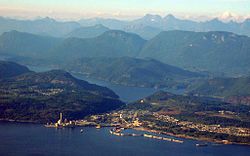This article needs additional citations for verification .(July 2023) |


The Hulks or The Giant Hulks, more formally known as the Powell River Floating Breakwater, is a floating breakwater off the Sunshine Coast of British Columbia, a Pacific coast province of Canada. The breakwater is a prominent landmark of the city of Powell River and may be the largest floating breakwater in the world.
Contents
The breakwater consists of floating concrete ships from the World War II era and one, SS Peralta, from the World War I era. Steel was in short supply during wartime leading to shipbuilders to resort to alternatives such a concrete. These heavy, awkwardly maneuverable ships were called "hulks". It was originally constructed by the Powell River Company, a pulp and paper mill, and the ships helped form their log pond.